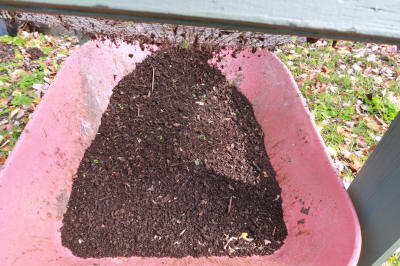 Well, another gardening season has passed. Hopefully your garden was successful and our articles on composting inspired you to start composting if it was not yet one of your gardening habits.
Well, another gardening season has passed. Hopefully your garden was successful and our articles on composting inspired you to start composting if it was not yet one of your gardening habits.
As with any endeavor, while we try to follow all the advice, nevertheless occasionally things do not turn out as we expect. Perhaps your pile started out well and then, slowed down or even stopped. This can happen for several reasons.
Perhaps the pile became too small. There is a critical mass to a compost pile: too small, and it will slow down or stop working. This may happen when the pile has exhausted most of the material you put in. The pile should be a three-by-three foot cube to work. A cube four or five feet on a side is more sustainable and still easy to turn.
Or the pile may have dried out. The microbes use the water we add to the pile to move about and to soften the material so they can begin breaking it down. Turning the pile and wetting it down will restart it. Add more material to it on a regular basis to maintain the size and aerate it. You’ll be rewarded with more compost.
You might have passed the pile one day and noticed an unpleasant odor. This, of course, is something we do not want. What’s wrong?
If the odor is one of rotten eggs or rotting material, this is caused by trying to compost the wrong kinds of material. The odor is the result of decaying meat, fish, or fatty, greasy solids. Maybe at some point we threw out without thinking about it a piece of meat or chicken or fish. Perhaps some food with butter, greasy frying pan drippings, salad dressing, milk or vegetable oil, or cheese or yogurt in it.
Naturally, we know enough not to put in dog or cat feces or other pet box litter. Besides being health hazards these will sour the pile every time. So leave them out. If they get into the pile, remove that part of the pile and dispose of it in the garbage. Get the pile as clean as you can and restart it with fresh garden waste and straw or dead leaves, wetting the material as you build it.
These materials will also draw rats, raccoons, skunks and other undesirable visitors. If you take away the food source these animals will stay away.
Perhaps the odor is the acrid smell of ammonia. This odor can develop all too easily. Adding too large a layer of green material, particularly, grass clippings, often is the cause of this odor. The material gets too much moisture and mats together. At this point the process of anaerobic decomposition begins. The compacted material has stuck together and formed a barrier that oxygen cannot penetrate. The nitrogen we were hoping would feed the microbes is now attracting and feeding an entirely different cast of characters. The result of their activity is the strong ammonia odor that tells us the pile is not working the way we want it to.
The fix here is an easy one – turn the pile and mix the material thoroughly with more brown, such as straw or dead leaves, making sure you don’t put in too much moisture. The excessive moisture is a large part of what caused the problem in the first place.
If in the course of turning your pile you see many long white threads, don’t be alarmed. These are put out by the fungi that are helping break down the pile. They are friends. You can turn the pile and treat it as usual.
The same can be said for finding a large number of earthworms or millipedes. Maybe there are some snails or beetles. Centipedes may be present in large numbers; or springtails may jump around. They are perfectly normal and should not cause alarm. Indeed, welcome them. Their presence means your pile has reached a level of maturity that is more advanced and is nearing completion.
Ants or the occasional mouse may show up. Especially as winter comes on, mice may move in to take advantage of the warmth. The ants took advantage of the warmth to hatch their eggs in the warmer months. Just turn the pile and carry on. They will leave. The ants will go when you have turned the pile and destroyed the nest.
To keep the mouse out you will need to create the pile in a container with solid side, slit-like vents and a secure cover that prevents its getting in. There are a variety of these on the market and a garden store or the internet will give you a choice.
If your pile cools down and stops during the winter, not to worry. This is a time of year when you may not have a ready supply of nitrogen-rich greens to balance the browns. Just wait until the spring comes and restart the pile when you have all the materials at hand.
And remember to set the finished compost aside for a few weeks to a month. This will allow the composting process to complete its breakdown of the material and the chemical processes that have been acting can conclude. This finished compost will help the structure of the soil and allow your plants to spread their roots more fully and take in the proper amount of nutrients. You will have a happier garden.
Read other articles on gardening techniques